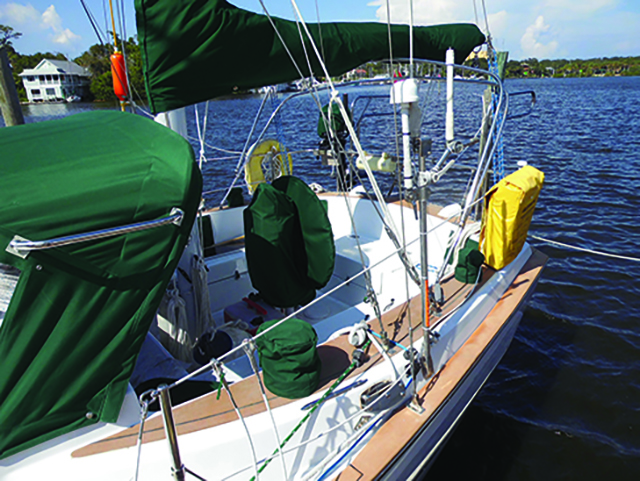Learn how to choose materials and sew canvas throughout your boat (published December 2013)
Over the last winter before we took our Pearson 424, Regina Oceani, back to saltwater after three years of refitting in a Colorado cornfield, we focused our work on the topside canvas.
SETTING UP
Before starting this project there were at least six sewing machines in our house, ranging from an antique Singer decorating the entryway to a computer-controlled do-everything Pfaff. None of them were up to the job of easily sewing the many layers of canvas and leather with heavy-weight thread. I knew I needed a sturdy walking foot sewing machine that would reliably handle the heavy sandwiches of canvas and be easy to take along when we went voyaging.
Over the years, the boat show demonstrations of the Sailrite Ultrafeed machines lured me in, but I needed to know if this machine was worth more than our Pfaff computer-controlled wonder machine. I also needed to know about the look-alike machines that sell for less. If you have followed this article series, you know by now that I never hesitate to call the top of any company to get the skinny on their products’ true performance.
Matt Grant at Sailrite took my call and walked me through the patented features and enhancements of their machines. He even pointed me to a nine-minute video on YouTube that compares machines and very clearly shows the quality control and improvements designed into the Sailrite Ultrafeed versus other machines. Matt promised I would never regret selecting a Sailrite machine. With over 50 linear yards of Sunbrella and thousands of yards of thread now having run though my Ultrafeed LSZ-1 machine with hardly a jam or a skipped stitch, and with the last stich being as even as the first, I can tell you he was right.
At their plant in Illinois, each Sailrite sewing machine is taken out of the box and is tested and tuned before it ships to a customer. The machines ship to customers along with the actual “proof of testing” sample stitches which run through thick stacks of tough materials like vinyl and canvas. Every machine also ships with a complete, easy-to-understand and well-illustrated manual; an instruction DVD; a tuning and repair DVD; and a tool kit.
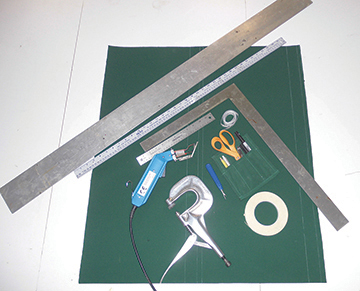
Among other key tools I gathered for the project was a hot knife with a removable guide foot. This seals and stops synthetic fabrics or lines from fraying while cutting through the materials and it has saved us tons of time over the course of our projects. Other necessities pressed into service were a soapstone pencil for laying out fabric cut and fold lines, a yellow china marker for laying out clear vinyl, Sharpie markers, pens and pencils, a seam ripper, quality fabric and thread scissors, a framer’s square, and a variety of rulers and straight edges. I also included a large work surface which was the same height as the sewing machine’s base to ease the layout and handling of large fabric pieces such as the dodger or mainsail stack pack.
I also made a few variations of belt holsters to hold the marking and cutting tools which otherwise seem to go astray on a table full of fabric. A broad assortment of snap fasteners and grommets with appropriately sized hole-punches and die sets completed my tool and hardware selection. Having used a hammer and handheld punch in the past, I sure didn’t regret spending extra for the Press-N-Snap tool and dies that quickly and reliably install snaps into fabric.
GETTING READY
The next step was selecting fabric materials and learning some basic sewing techniques. This might seem simple enough, but little did I know how confusing it could be when selecting Sunbrella fabric. There are several types of Sunbrella material and many alternative products: acrylics and polyesters; acrylics coated with polyurethane or flocking, and even laminated with vinyl; polyesters coated with acrylic; soft backings; rough backings; and the list goes on and on. Weights, widths and warranties also vary.
I contacted my Glen Raven (the makers of Sunbrella) regional rep, Tim Martin, for advice on which of their many materials to use. (See table.) In the end I settled on basic Sunbrella marine and awning fabric for most surfaces. For the bimini and dodger, I chose Sunbrella Supreme that has an inside surface of smooth flocking. I did not see a need for Sunbrella Plus which has a polyurethane waterproof coating on one side, or Sea Mark which is a Sunbrella laminated by another company (Haartz) using marine-grade vinyl. I may consider these when I get around to making a new set of dinghy chaps. The fact that Sunbrella is solution-dyed acrylic, meaning the dye is in every thread and is thus very color-stable, and has a10-year warranty sold me on my choices. If I were going to invest all this time in these projects, I did not want to have to redo them because the material prematurely failed or faded. In addition, I secured some vinyl for making a gear bag and parts of the dinghy chaps, as well as some Dacron sailcloth to reinforce and line parts of the mainsail stack pack.
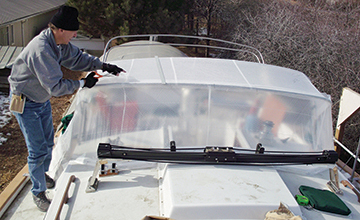
Selecting the material for the window of the dodger was also an education in options. Vinyl sold on rolls is made by extruding the material through rollers in a process called “calendaring.” Good roll vinyls, such as Plastipane, come in lighter gauges. These inexpensive vinyls can be very flexible when new. But they also tend to have limited lives, reduced optical clarity, and less stain, scratch or UV resistance. Good pressed-sheet vinyls, such as Strataglass and O’Sullivan’s O’Sea, are made by pressing two sheets of material together under heat between two highly polished plates. The polished plates provide the superior optical clarity of such products. The formulation and coatings on the outer layers of the material provide the high levels of scratch, stain and UV resistance. Pressed-vinyl products come in thicker gauges. Material in 30 and 40 gauge, which equal a thickness of 30- and 40-thousandths of an inch—or mils—are typically used for dodger windows. I selected 40-gauge O’Sea as it was a bit more flexible than the same thickness of Strataglass.
YOU CAN—WITH VIDEOS
Next came the how-to knowledge. For this I looked to the extensive video library at the Sailrite website, many of which are also found on YouTube. I started with the “Zippers 100” series followed by a few videos on the various types of zipper pulls, the installation of curved zippers, and the how-tos of selecting and installing snap fasteners and grommets. Soon I progressed into videos about making hatch covers, plus one on making a binnacle cover. These equipped me with basic principles and readied me for the double DVD set on dodger construction and a DVD on bimini construction. These DVDs are sold by Sailrite and are worth many times their price. (Previews are available on their website.) They also include printable instructions that proved to be invaluable references at the sewing table. Matt Grant and his chief seamstress, Deb, are featured in most of these videos, which are a family affair, with Matt’s brother Eric handling the filming and production. They are skilled and patient teachers—willing to repeat anything at the press of the remote control.
90 PERCENT PREP, 10 PERCENT SEWING
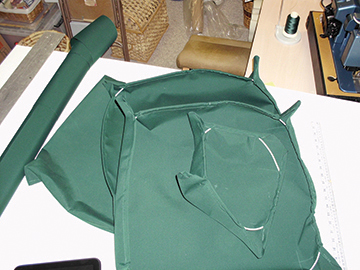
I started small and simple with instrument and hatch covers. These projects cemented the layout concepts of seam allowance, darts and bungee/draw-string pockets. Next I made the simple mizzen sail cover with Common Sense fasteners along its bottom edge. Then I graduated to the bimini and dodger. After that, reproducing the stack pack and making sea hoods for the hatches and forward companionway were simple projects. Bags and a life raft cover were quick, “oh, I have an hour; what could I make?” types of projects.
I learned quickly, though, that running the sewing machine is the smallest part of sewing; designing, laying out, cutting and assembling take up most of the time. Reinforced plastic sheeting, such as Dura-Skrim, is a great material to work with when designing and laying out complicated shapes such as the pieces of a dodger or a fitted cover for a binnacle. Strapping tape can be applied to frame tubes or used to create a skeleton where key seams or darts will likely end up. On top of the strapping tape, double-stick basting tape works well to hold the scrim material in place. Sharpie markers write easily on the scrim to illustrate where seams or darts will be and are great for note-making. The same double-stick tape can be used to hold fabric pieces together at their seams in preparation for sewing. Sewing seams together without the tape is certainly achievable, but the tape makes the alignment of pieces more precise and the whole job much easier. The strapping tape comes off easily, however, double-stick basting tape sticks tenaciously to metal tubing.
PAUSE AND FIT
While making and following patterns can often lead to a precisely finished product, I found that pausing at intermediate points in the assembly and sewing was prudent to allow for adjustments and a finer fitting on the boat’s details. Final darts in my windlass cover and binnacle cover benefited from a few roundtrips between the sewing table and the boat. In retrospect, with the Sailrite Ultrafeed sewing machine being portable, I could have saved the trips by just bringing the machine to the boat.
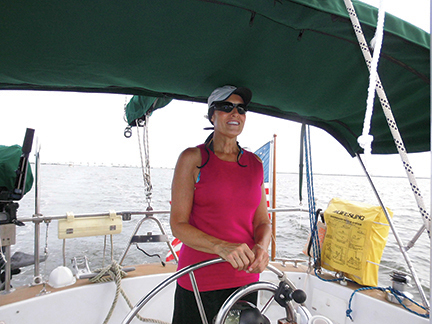
Now we are ready to move our boat to Florida with the dodger, bimini, main stack pack, mizzen, sea hoods, hatch and windlass covers, companionway drop board and instrument covers, and wheel cover all completed. Once the rig is stood up, we will complete the removable panels between the dodger and bimini. Also, a set of foredeck awnings and chaps for the dinghy are planned for next winter’s projects. With the skills learned through these progressive projects, there is no telling what we might sew next. We’re ready to sew anything now.
BWS has followed Pete and Jill Dubler’s refit and restoration of their Pearson
424, Regina Oceani. Pete emphasizes that doing the work yourself creates intimacy and familiarity with her systems and a special pride in your boat that writing checks just can’t offer.
KEEPING VINYL WINDOWS CLEAR AND SOFT
The clear vinyl material used for dodger windows contains chemicals known as plasticizers to keep them soft and pliable. The polymer topcoat of the vinyl provides scratch protection and is intended to keep plasticizers in the vinyl. Over time though, the plasticizers migrate to the surface of the material where they can oxidize and cloud or discolor the vinyl. To prevent this, windows should be regularly washed with fresh water and cleaned with a product such as IMAR Strataglass Protective Cleaner. Every three to four months the vinyl should be polished and the protective coating restored with a product such as IMAR Strataglass Protective Polish. For dodgers that are left standing, removable snap-on Sunbrella covers can be used to reduce UV exposure and increase the life of the vinyl windows.
TWELVE TIPS FOR GREAT CANVAS SEWING
• Lock stiches at start and end of a seam by sewing back over the stitches in reverse and then forward again
• Thread won’t pull out of the needle when you start sewing if you start with the thread’s take-up arm in its top position
• To crease fabric, roll it over edge of table
• Spool up lots of spare bobbins at the start of a project
• Watch the Sailrite zipper videos
• Double check fabric layup before sewing
• Use zigzag stitching for most rigorous applications
• No zipper foot is needed if you have a zigzag machine and can set the needle to the left or right
• On a zigzag machine, pick up the bobbin thread with the needle in the center position
• It is easy to bump the needle position-selector when loading a bobbin into the machine—double check the needle position before sewing
again
• Basting tape will be your new best friend—keep plenty on hand
• Like reefing, if you think the bobbin is about to run out, it’s probably too late

















